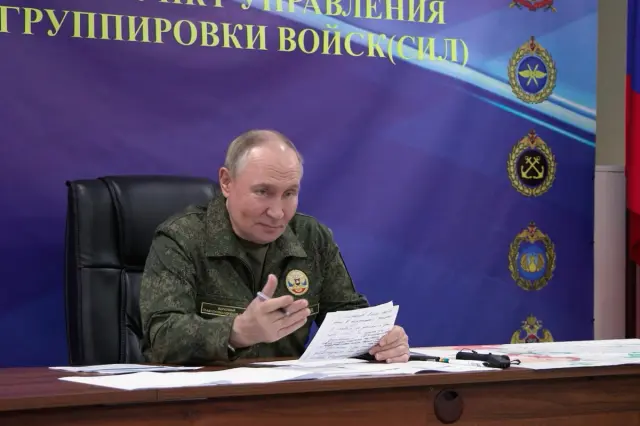-
In Trump-Friendly Iowa, the President’s Policies Have Hit Hard - 17 mins ago
-
Nick Mangold Dead at 41: Latest Tributes to New York Jets Great - 21 mins ago
-
Lane Kiffin Responds to Backlash Over Postgame Behavior vs Oklahoma - 57 mins ago
-
Can Cuomo Sway Trump Voters Away From Sliwa in the NYC Mayor’s Race? - about 1 hour ago
-
Police arrest two suspects in fatal shooting of California strip club manager - about 1 hour ago
-
How to Watch Browns vs Patriots: Live Stream NFL Week 8, TV Channel - 2 hours ago
-
Turkey Offered to Help in Postwar Gaza. Israel Isn’t About to Say Yes. - 2 hours ago
-
Sports Daily: A Different Kind of World Series History - 2 hours ago
-
A Break-In That Shook France - 2 hours ago
-
LSU Fans Beg 5-Star Commit to Stay With Program After Texas A&M Loss - 3 hours ago
Putin Hails ‘Unique’ Nuclear-Powered Cruise Missile After Latest Test
Russian President Vladimir Putin has hailed the country’s “unique” nuclear-powered Burevestnik missile after the military carried out new tests of the long-range missile and several of Moscow’s most destructive weapons.
The Context
The Burevestnik, also known by its NATO moniker, SSC-X-9 Skyfall, is a ground-launched, nuclear-powered cruise missile. It was first unveiled by Putin in March 2018 with a host of other next-generation weapons, including the so-called “doomsday device” Poseidon, a nuclear-powered, nuclear-tipped torpedo. Russia claims the Burevestnik has a range long enough to strike the U.S. and is able to dodge Western air defenses.

What To Know
The missile is a “unique product, unlike anything else in the world,” Putin said in remarks reported by state media on Sunday.
Valery Gerasimov, Russia’s most senior general, told Putin the Burevestnik had covered roughly 14,000 kilometers, or 8,700 miles, in a 15-hour test flight on October 21. “This is not the limit,” Gerasimov, the chief of the general staff of Russia’s military, said in comments published by the Tass state news agency.
A U.S. military intelligence assessment from 2020 described the weapon as giving Russia a “unique weapon with intercontinental range capability,” although some Western analysts have been skeptical of the missile’s true capabilities.
The Kremlin said on October 22 that Putin had supervised a host of strategic nuclear weapon tests of sea-, air- and ground-launched weapons, but did not mention Burevestnik. Russia tested a Yars intercontinental ballistic missile and a Sineva submarine-launched ballistic missile, while a strategic bomber aircraft launched unspecified cruise missiles, according to a government readout.
The tests came as the U.S. imposed a raft of sanctions on Russia after many months of drawn-out negotiations over Ukraine with little progress, much to the overt frustration of U.S. President Donald Trump. The Republican had long resisted slapping Moscow with sanctions designed to hinder Russia’s ability to wage war in Ukraine.
The White House has prepared additional sanctions against Russia, to be used if the war in Eastern Europe continues to drag on, Reuters reported on Saturday, citing a U.S. official and another person familiar with the matter.
The news agency reported in mid-August that Russia was likely preparing another Burevestnik test at its Pankovo test site, on the Novaya Zemlya archipelago in the Barents Sea. Novaya Zemlya has served as a major nuclear test site for decades.
The Burevestnik’s development is thought to have started in 2011 and tests likely began in 2016. Before 2019, Russia had tested it a probable 13 times “with two partial successes,” the U.S.-based nonprofit Nuclear Threat Initiative said at the time. Putin said in October 2023 that Russia had carried out another round of tests on the missile.
U.S.-based analysts have said the Burevestnik “faced serious setbacks” and floated back in 2023 that the program had been put on hold.
What People Are Saying
General Valery Gerasimov said on Sunday, according to state media: “The missile was in the air for about 15 hours and this is also not the limit.”
Source link
















